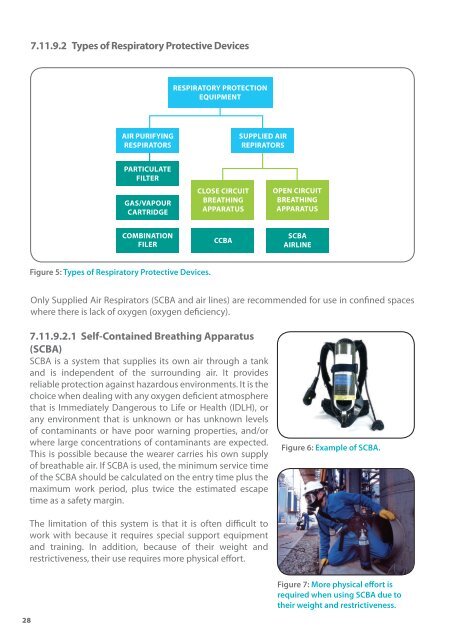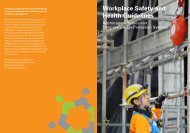Confined Spaces - Workplace Safety and Health Council
Confined Spaces - Workplace Safety and Health Council
Confined Spaces - Workplace Safety and Health Council
- No tags were found...
Create successful ePaper yourself
Turn your PDF publications into a flip-book with our unique Google optimized e-Paper software.
7.11.9.2 Types of Respiratory Protective Devices7.11.9.2.2 Airline RespiratorAn airline respirator is recommended when entry with a normal SCBA is physically restricted<strong>and</strong>/or the work duration is longer than the service time of the SCBA.Air PurifyingRespiratorsParticulateFilterGas/VapourCartridgeCombinationFilerFigure 5: Types of Respiratory Protective Devices.Respiratory ProtectionEquipmentClose CircuitBreathingApparatusCCBASupplied AirRepiratorsOpen CircuitBreathingApparatusSCBAAirlineOnly Supplied Air Respirators (SCBA <strong>and</strong> air lines) are recommended for use in confined spaceswhere there is lack of oxygen (oxygen deficiency).7.11.9.2.1 Self-Contained Breathing Apparatus(SCBA)SCBA is a system that supplies its own air through a tank<strong>and</strong> is independent of the surrounding air. It providesreliable protection against hazardous environments. It is thechoice when dealing with any oxygen deficient atmospherethat is Immediately Dangerous to Life or <strong>Health</strong> (IDLH), orany environment that is unknown or has unknown levelsof contaminants or have poor warning properties, <strong>and</strong>/orwhere large concentrations of contaminants are expected.This is possible because the wearer carries his own supplyof breathable air. If SCBA is used, the minimum service timeof the SCBA should be calculated on the entry time plus themaximum work period, plus twice the estimated escapetime as a safety margin.The limitation of this system is that it is often difficult towork with because it requires special support equipment<strong>and</strong> training. In addition, because of their weight <strong>and</strong>restrictiveness, their use requires more physical effort.Figure 6: Example of SCBA.Figure 7: More physical effort isrequired when using SCBA due totheir weight <strong>and</strong> restrictiveness.Breathing air from an airline respirator normally comes from a trolley-mounted cylinder(s)positioned in safe zones in close proximity to the user, from a compressor or a combination ofboth. The breathing air is then supplied to the user by the breathing hose which is normallyconnected to a lightweight harness to provide the user with an uninterrupted air supply.When compared to the more conventional SCBA, this arrangement provides greater freedom ofmovement <strong>and</strong> less fatigue to the user.7.11.9.2.3 Air Purifying (Cartridge) RespiratorAir Purifying (Cartridge) Respirators offer no protection against oxygen deficiency.It is basically a filtering system that cleans the airbeing inhaled. Air-Purifying Respirators (APR) can removecontaminants in the air that the person breathes by filteringout particulates (e.g., dusts, metal fumes, mists, etc.). OtherAPRs purify air by adsorbing gases or vapours on a sorbent(absorbing material) in a cartridge or canister. They aretight-fitting <strong>and</strong> are available in several forms:• Half-face mask (covering the face from the nose tobelow the chin), or• Full face piece (covering the face from above the eyesto below the chin). Respirators with a full face piece alsoprotect the eyes from exposure to irritating chemicals.Figure 8: Example of Air Purifying(cartridge) Respirator.The limitation of APR is that the system depends on the surrounding air for oxygen <strong>and</strong> filters thecontaminants from the person’s breathing air. It is critical that the atmosphere of the confinedspace contains at least 19.5% oxygen. It is also neccessary to know the approximate concentrationof contaminants to ensure that the respirator’s capabilities are not exceeded. The concentrationof contaminants cannot exceed the IDLH levels <strong>and</strong> it is necessary for the person to be fit-testedto ensure the correct size of respirator before use.It is important not to use any kind of filtering respiratory protection device:• In oxygen deficient atmospheres (less than 19.5 vol. % O2);• In poorly ventilated areas or confined spaces, such as tanks, tunnels, or vessels;• In atmospheres where the concentrations of the toxic contaminants are unknown or areIDLH; or• When the concentration of a contaminant is higher than the maximum permissibleconcentration <strong>and</strong>/or the filter class capacity.It is also important to ensure that:• It fits properly; <strong>and</strong>• If both gases <strong>and</strong> particles are present, the combination filter is used to filter out both gases<strong>and</strong> particles.28 29
















